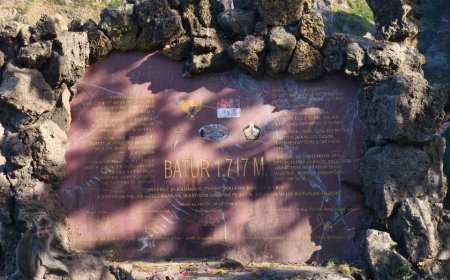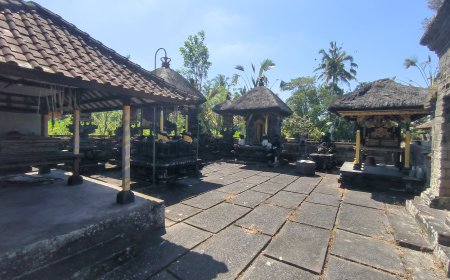Pura Taman Sari, Pupuan Village: A Place to Seek Blessings, Healing, and Offspring
Pupuan Village in Bali is an ancient village with a rich history and traditions, evidenced by the Bahtiran Inscription and sacred rituals like the Rejang Ayunan Dance. This village is home to Pura Taman, a holy temple with an ancient palm-leaf manuscript and a sacred stone, where locals pray for offspring, healing, or success. While the temple has evolved over time, its sanctity remains carefully preserved.

Pupuan Village is one of Bali's ancient villages, with historical evidence such as the Bahtiran Inscription, which reflects the village's long-standing and significant role in Balinese civilization. Being an old village, Pupuan is rich in traditions and rituals that have been preserved in their original form to this day, reflecting a profound cultural heritage. Various sacred traditions passed down through generations are still maintained here, such as the Rejang Ayunan Dance, Balawadwa Dance, and Rejang Pulu. These dances are not merely entertainment; they are sacred rituals that are part of religious ceremonies and are believed to hold strong spiritual significance.
Moreover, Pupuan Village has several temples that are considered highly sacred and serve as centers of worship and spiritual activities for the community. Notable temples include Pura Griya Sari Udaya Raya and Pura Taman, both of which carry deep historical and spiritual meanings for the villagers.

Pura Taman Sari, Pupuan Village (Source: Personal Collection)
Pura Taman is closely tied to the existence and history of the traditional Pupuan Village. In the past, Pupuan Village was a settlement consisting of a group of residents. To the east of this village, there stood a temple known from the beginning as Pura Taman. Initially, this temple was just a simple stone structure maintained by four households responsible for its upkeep. Over time, as the residents of Pupuan Sege moved southward, Pura Taman continued to be preserved and managed by these four households. However, with the establishment of the Tri Kahyangan temples, Pura Taman now appears isolated from Pupuan Village, situated in the middle of forests and rice fields.

Puseh and Gedong (Source: Personal Collection)
Pura Taman has a sacred palm-leaf manuscript stored at the Taksu Jro Mangku’s house. This manuscript is sanctified on Saraswati day and the full moon of the Kedasa month and is only read by certain individuals involved in worship at the temple. Although it has been examined by archaeologists, the expected results have yet to be obtained. Reading this manuscript aims to determine when Pura Taman was established and whom it venerates. There is also a belief that a stone in this temple marks where a sacred figure reached moksha at midnight on the full moon of the Kedasa month. Therefore, the peak of the temple's piodalan ceremony takes place during the full moon of Kedasa.
Over time, many supernatural occurrences have been reported at Pura Taman. People who come to this temple often make requests, promising to help maintain the temple if their wishes are granted. Common requests include asking for offspring, whether a son or daughter. In this ritual, the temple's inscription is lowered and dipped into holy water. Through a ritual believed to be sacred, those seeking children often find their wishes fulfilled.

Piasan of Pura Taman Sari (Source: Personal Collection)
In addition to requesting offspring, people also seek healing for illness, confusion, or speech difficulties. After being purified (cleansed) in three locations around the temple, many find themselves healed. People seeking employment also often come to ask for blessings, with many succeeding in their careers.
Initially, Pura Taman was cared for by just four households, but over time, the number of guardians, or pengempon, has grown to 102 households. Most come from Pupuan Village, but many also come from other places like Buleleng, Tabanan, and even Denpasar.

The Pakuaji Tree (Source: Personal Collection)
As time passed and the number of pengempon increased, Pura Taman underwent various changes and developments to meet the spiritual needs of the worshippers. Initially, this temple was only a simple stone structure serving as a place of worship, but now Pura Taman has various shrines to honor Ida Betara, who resides in the temple. This change is not merely physical but also represents an effort to maintain the temple's sanctity and relevance for the guardians and the worshipping community.
Initially, worship at Pura Taman was conducted beneath a large, sacred Pakuaji tree. This tree, believed to have existed since ancient times, symbolizes a sacred manifestation of nature and is thought to be the residence of Ida Betara. However, over time, the tree required adjustments due to its age. To maintain the solemnity and order of worship, various shrines were constructed as places for the deities and other sacred symbols. One of the main shrines now found in Pura Taman is the Puseh Shrine, built to honor the village's protective deity.

Pesiraman Shrine, Ratu Mas Meketel Shrine (Source: Personal Collection)
Pura Taman has several sacred elements, including a water fountain for the first purification ritual, a beji (sacred spring) for the second purification, and the temple’s courtyard for the third purification. Strict rules apply, such as a ban on bringing pork into the main sanctuary (utama mandala). The inscription may only be touched by certain individuals, and the genta (sacred bell) may only be sounded when holy water (tirta) is being retrieved.
Pura Taman is often accompanied by the resounding sound of gongs, enhancing the temple’s sanctity. Thus, the brief history of Pura Taman, which remains an essential part of the spiritual life of Pupuan Village’s community.































































